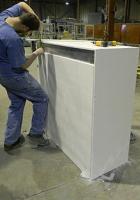Refractory castable Information
Castable Refractories Information
CASTABLE REFRACTORIES can be installed similarly to normal concrete. It is very convenient and easy to use for building up the kiln structure. Castable refractories has high refractoriness close to refractory bricks but it can be installed in a shorter time. It consists of high alumina cement and refractory aggregates with a proper grain size distribution, thus it can develop strength after being mixed with a specific amount of water.
Castable Refractories has advantages over refractory bricks as it is easy and convenient to use, requires no cutting , has less lead time in manufacturing, thereby reducing the cost of making a new mould if an irregular shape is required, and is suitable for installing in an area where the bricks installation cannot be perfectly done.
Mixing and Installing Castable Equipment
1. A Pan Mixer, with 35-40 rpm speed, for rapid and homogeneously mixing of the castables with water
2. A Vibrator, minimum 1-inch diameter at a frequency of 10,000-15,000 cycles/minute, for high and uniform density castables.
3. A Graduated Cylinder and A Stopwatch
Castable Refractories' Classification
1. Conventional Castables
This product is ready to use as the binder and aggregates are already mixed and packed in one bag. There are many classifications for a service
temperature ranging from 1000 oC to 1800 oC. The required amount of water for this type of castables, which will result in good flowability,
is between 10-15%. This enables the castable to be easily cast and suitable for general use.
2. Low Cement Castables (LCC)
The lime (CaO) content indicates the refractoriness of the castables. The lower the lime content, the better the castable. LCC has lime content
between 1.0-2.5%. This range of lime content allows the LCC to have more prominent properties than the conventional castable such as having no remarkable
strength drop during heating up, high strength at room temperature and service temperature, better abrasion resistance, better thermal shock resistance, and better alkali-attack resistance.
3. Ultra Low Cement Castables (ULCC)
The ULCC has a very low lime (CaO) content which is between 0.2-1.0%. Therefore, the properties of ULCC are superior to the LCC as it has higher service temperature,
higher strength and higher abrasion resistance.
Storage of the Castables
1. Keep in a dry and air-ventilated shelter
2. For convenience, keep the castables separately by quality classifications
3. Do not stack up for more than two pallets of castables
Castable Refractories User Guide
Casting Procedure
1. Use of non-leakage mould, either wood or steel. They must be lubricated with oil, grease or paraffin so the casts can be easily released.
2. The vibrator should be gradually moved upward and slowly pulled out from the castables' surface to prevent formation of holes or air bubbles. If the amount of water for the mix is not enough or if the mix is too dry, holes can be found after the vibrator is pulled out
3. Provide a suitable period of time for the vibration of the castables. Stop vibrating when water comes up on the surface and no more air bubbles are present. Prolonged vibration time may cause segregation of the refractory grain, which will reduce the strength of the castables. The explosion of the castables due to the segregation may also occur because the fine particles move up and cover the surface of the castables so the water cannot be easily evaporated.
4. The surface of the castables should not be smoothened so that water can be easily evaporated.
Curing
After casting, the castables must be cured to prevent cracks which may result from rapid evaporation of surface water. For curing, cover the castables' surface with plastic sheet or fully water-saturated cloth for 24 hours. The mould can be removed after 8 hours and continue curing until the curing time is 24 hours in total. Then remove the covering and dry the castables in air for another 24 hours.
Preheating furnace
Preheating of the castables is essential for eliminating the existing water. Free water remaining in pores can be eliminated by heating the castables up to 100 o to 200 o C. For the water from hydration of high alumina cement will be eliminated at the temperature between 250 o C and 350 o C. During a rapid increasing of temperature, steam pressure is developed and it may cause an explosion of the castables. Thus furnaces must be preheated at an appropriated heating rate before operating. The preheating operation can be followed as shown in the preheating graphs.
Elimination of the Remaining Mixed Castable
It is safe to landfill the disposal castables



